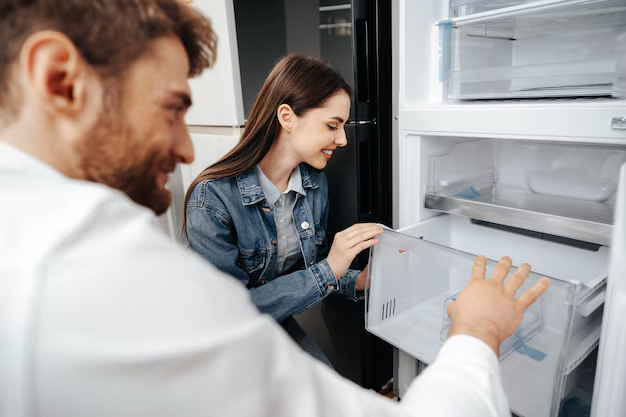Changing Temperature on Your Samsung Refrigerator: A Complete Guide
Have you ever opened your fridge only to find that the milk is frozen, or perhaps your vegetables have wilted? Ensuring the correct temperature setting on your Samsung refrigerator is key to maintaining the freshness and safety of your food. In this guide, we'll explore how to adjust the temperature in a Samsung refrigerator, why it matters, and other related insights to help you get the most out of your appliance.
Understanding the Importance of Refrigerator Temperature
Why Correct Temperature Matters
The temperature of your refrigerator can significantly impact the quality and safety of your stored food. Maintaining the right temperature:
- Preserves Food Quality: A consistent and correct temperature helps in retaining the texture, nutritional value, and taste of your food.
- Prevents Food Waste: By preventing spoilage, you save money and reduce waste.
- Ensures Food Safety: Correct temperatures inhibit the growth of harmful bacteria that could cause foodborne illnesses.
Optimal Temperature Settings
For most Samsung refrigerators, the ideal temperature is around 37°F (3°C) for the fridge and 0°F (-18°C) for the freezer. These settings minimize bacterial growth and keep your food fresh longer.
How to Adjust the Temperature on a Samsung Refrigerator
Steps to Change the Temperature
Locate the Control Panel: Most Samsung refrigerators have a digital display located inside the fridge door or on the front panel. This panel will allow you to control the temperature.
Press the Fridge or Freezer Button: Depending on which compartment you want to adjust, press the corresponding button. For models with touch screens or digital displays, the current temperature will be shown.
Adjust the Temperature: Use the arrow buttons or dial to increase or decrease the temperature to the desired level. Allow 24 hours for the refrigerator to adjust to the new settings.
Troubleshooting Temperature Issues
- Inconsistent Temperature: Make sure the refrigerator isn't overstuffed, which can block air vents and lead to temperature fluctuations.
- Display Panel Malfunctions: Reset the refrigerator by unplugging it for a minute and then plugging it back in. If problems persist, consulting a professional might be necessary.
Enhancing Energy Efficiency
How to Improve Refrigerator Efficiency
Keeping your Samsung refrigerator running efficiently is beneficial for both your wallet and the environment. Here are some actionable steps:
- Regularly Clean the Coils: Dusty coils can cause the compressor to work overtime.
- Check Door Seals: Ensure that the door seals are tight, with no gaps. Worn gaskets can be replaced.
- Avoid Overloading: Allowing air to circulate freely keeps the fridge cooler with less energy.
Benefits of Energy Optimization
- Reduced Electricity Bills: Efficient appliances consume less electricity.
- Prolonged Appliance Lifespan: Reduces wear and tear, extending your refrigerator’s useful life.
- Environmentally Friendly: Lower energy use contributes to decreased environmental impact.
Smart Features in Samsung Refrigerators
Exploring Technology Integration
Samsung refrigerators often come packed with smart features designed to make your life easier. Here’s how to leverage these functionalities:
- SmartThings Integration: Use the Samsung SmartThings app to control your fridge remotely. You can monitor temperatures, change settings, and receive updates on issues directly to your phone.
- Food Management Apps: Smart fridges may include inventory management features or recipe integrations that use stored ingredients.
- Energy Saving Modes: Features like vacation mode can help save energy when you’re away.
Basic Troubleshooting for Temperature Problems
Diagnostic Tips
Experiencing issues even after adjusting the temperature? Here are some basic troubleshooting steps:
- Unplug and Inspect: Turn off and unplug the appliance, then inspect it for visible issues like worn seals or blocked vents.
- Reset the Temperature Settings: You can try reverting to factory temperature settings before setting it again.
- Consult the Manual: The user manual provides model-specific troubleshooting tips and solutions.
Professional Help
If basic troubleshooting doesn’t resolve your issues, a certified technician can offer more comprehensive diagnostic and repair services.
Key Takeaways for Managing Samsung Refrigerator Settings
📝 Quick Summary:
- Optimal Temperatures: Fridge at 37°F (3°C); Freezer at 0°F (-18°C).
- Adjusting Temperature: Use the digital display panel to set and check current temperatures.
- Energy Efficiency: Keep coils clean and check door seals to save energy.
- Smart Features: Use SmartThings for remote management and energy-saving modes for efficiency.
- Troubleshooting: Check for blockages and readjust settings if needed—consult professionals for unresolved issues.
Concluding Insights
Maintaining the right temperature in your Samsung refrigerator is crucial for food safety and appliance efficiency. With smart technology and thoughtful maintenance, you can ensure your fridge keeps your food fresh and your utilities low. Taking the time to understand and adjust your temperature settings properly ensures that your refrigerator serves you well for years to come. Always refer to your refrigerator's manual for model-specific advice and remember that small changes can have big impacts on your kitchen operations.
